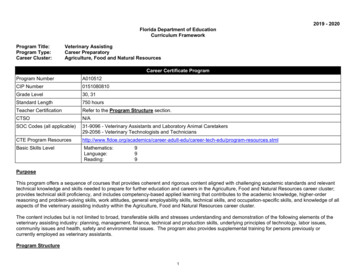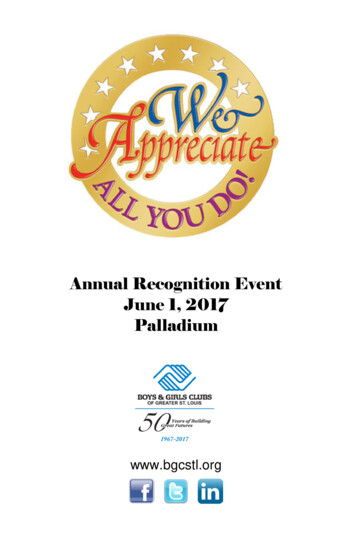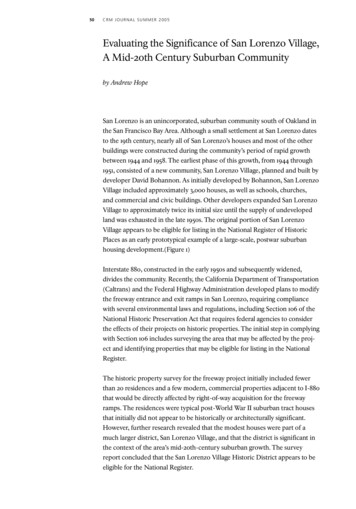
Transcription
Florida Department of EducationCurriculum FrameworkProgram Title:Program Type:Career Cluster:2019 - 2020Veterinary AssistingCareer PreparatoryAgriculture, Food and Natural ResourcesCareer Certificate ProgramProgram NumberA010512CIP Number0151080810Grade Level30, 31Standard Length750 hoursTeacher CertificationRefer to the Program Structure section.CTSON/ASOC Codes (all applicable)31-9096 - Veterinary Assistants and Laboratory Animal Caretakers29-2056 - Veterinary Technologists and TechniciansCTE Program lt-edu/career-tech-edu/program-resources.stmlBasic Skills LevelMathematics:Language:Reading:999PurposeThis program offers a sequence of courses that provides coherent and rigorous content aligned with challenging academic standards and relevanttechnical knowledge and skills needed to prepare for further education and careers in the Agriculture, Food and Natural Resources career cluster;provides technical skill proficiency, and includes competency-based applied learning that contributes to the academic knowledge, higher-orderreasoning and problem-solving skills, work attitudes, general employability skills, technical skills, and occupation-specific skills, and knowledge of allaspects of the veterinary assisting industry within the Agriculture, Food and Natural Resources career cluster.The content includes but is not limited to broad, transferable skills and stresses understanding and demonstration of the following elements of theveterinary assisting industry: planning, management, finance, technical and production skills, underlying principles of technology, labor issues,community issues and health, safety and environmental issues. The program also provides supplemental training for persons previously orcurrently employed as veterinary assistants.Program Structure1
This program is a planned sequence of instruction consisting three postsecondary adult courses that comprise three occupational completionpoints. Planned and Supervised Agricultural Experiences (SAE) must be provided through one or more of the following: (1) directed laboratoryexperience, (2) student project, (3) placement for experience, or (4) cooperative education.This program is comprised of courses which have been assigned course numbers in the SCNS (Statewide Course Numbering System) inaccordance with Section 1007.24 (1), F.S. Career and Technical credit shall be awarded to the student on a transcript in accordance with Section1001.44 (3)(b), F.S.To teach the course(s) listed below, instructors must hold at least one of the teacher certifications indicated for that course.The following table illustrates the post-secondary program structure:OCPACourse NumberATE0006BATE0070CATE0072Course TitleVeterinary Assistants and Laboratory AnimalCaretakers 1Veterinary Assistants and Laboratory AnimalCaretakers 2Veterinary Assistant2Teacher CertificationAGRICULTUR 1 @2AGRI @2AG SUPPLI @7 GVET ASSIST 7GLength450 hoursSOC Code31-9096150 hours31-9096150 hours29-2056
Common Career Technical Core – Career Ready PracticesCareer Ready Practices describe the career-ready skills that educators should seek to develop in their students. These practices are not exclusiveto a Career Pathway, program of study, discipline or level of education. Career Ready Practices should be taught and reinforced in all careerexploration and preparation programs with increasingly higher levels of complexity and expectation as a student advances through a program ofstudy.1. Act as a responsible and contributing citizen and employee.2. Apply appropriate academic and technical skills.3. Attend to personal health and financial well-being.4. Communicate clearly, effectively and with reason.5. Consider the environmental, social and economic impacts of decisions.6. Demonstrate creativity and innovation.7. Employ valid and reliable research strategies.8. Utilize critical thinking to make sense of problems and persevere in solving them.9. Model integrity, ethical leadership and effective management.10. Plan education and career path aligned to personal goals.11. Use technology to enhance productivity.12. Work productively in teams while using cultural/global competence.3
StandardsAfter successfully completing this program, the student will be able to perform the Describe veterinary science and the role of animals in society.Describe the socioeconomic role of veterinary sciences on the companion animal livestock industries.Discuss the human-animal bond and its effects on human health.Demonstrate the proper use of veterinary science terminology.Identify careers in the animal industry.Practice safety.Recognize normal and abnormal animal behaviors.Restrain and control companion and livestock animals.Identify common breeds of companion animals and husbandry practicesDemonstrate human-relations, communications and leadership through FFA activities.Demonstrate basic first aid for companion and livestock animals.Demonstrate the use of tools, equipment, and instruments in the veterinary science and companion animal industryDemonstrate proper techniques in taking vital signs.Investigate the common breeds and husbandry practices for several species of animalsIdentify parts and functions of various systems of common companion and livestock animals.Explain the various methods of animal identification.Demonstrate knowledge of animal control and animal welfare organizations.Describe the problems, causes, and solutions of animal overpopulation.Locate and interpret animal-related laws, in state statutes, or local ordinancesIdentify the different digestive systems of animals and the nutritional requirements of selected species.Explain the reproductive system and breeding of common companion and livestock animals.Investigate the common husbandry practices and daily care of companion animals and exotic animals and fish.Demonstrate knowledge of preventive medicine and disease control.Demonstrate human-relations, communications, leadership and employability skills.Differentiate between animal welfare and animal rights.Explain the role of animals in research.Maintain and analyze records.Explain proper sanitation for animal facilitiesExplain diagnostic testing and use of equipmentDescribe internal and external parasites and control methods.Groom selected companion and livestock animals.Describe exotic animals and the effects of captivity on them.Assess techniques used in surgical assisting and surgical preparation.Explain principles of pharmacologyExplain proper methods of syringe and hypodermic needle use.4
Florida Department of EducationStudent Performance Standards2019 - 2020Program Title: Veterinary AssistingCareer Certificate Program Number: A010512Benchmarks that appear in bold within the framework are skills or competencies that have been taken directly from the FVMA SkillsCompetency Validation list. The most up to date validation list can be found on the FVMA website.Course Number: ATE0006Occupational Completion Point: AVeterinary Assistants and Laboratory Animal Caretakers 1– 450 Hours – SOC Code 31-909601.0Describe veterinary science and the role of animals in society – the students will be able to:01.01 Define veterinary science.01.02 Identify key components in the domestication of animals.01.03 Choose current issues facing the animal industry today and describe the effect of each on society.02.0Describe the socioeconomic role of veterinary sciences on the companion animal and livestock industries – the students will be able to:02.01 Summarize the history of the veterinary science, companion animal and livestock industry.02.02 Discuss the role of companion animals on the veterinary science industry.02.03 Discuss the role of livestock animals on the veterinary science industry.03.0Discuss the human-animal bond and its effects on human health – the students will be able to:03.01 Describe the human-animal bond and its influence on veterinary care.03.02 Compare and contrast different types of human-animal bonds for companion animals, working animals and livestock.03.03 Discuss the positive health effects on people resulting from their interaction with animals.03.04 Discuss programs that use human-animal interaction as a therapy tool.03.05 Describe the characteristics of animals used in the animal-facilitated therapy programs.03.06 Describe national and local programs that use animal-facilitated therapy.5
03.07 Discuss stages of grief of animal loss.04.0Demonstrate the proper use of veterinary science terminology – the students will be able to:04.01 Define common veterinary and medical terms, including directional terminology.04.02 Compile a list of prefixes, suffixes, and root words for veterinary medical terminology.04.03 Categorize gender and species-related terminology.04.04 List common medical and veterinary abbreviations05.0Identify careers in the animal industry – the students will be able to:05.01 Differentiate between entry and advanced level animal-industry careers.05.02 Identify professional organizations and trade journals in the animal industry.05.03 Investigate career opportunities in the veterinary science, companion animal, and large animal industry; also identify degree orcredential needed to prepare for those careers.05.04 Using national or state credentialing agencies as a reference, distinguish between a Veterinary Assistant, Credentialed VeterinaryAssistant, Veterinary Technician, Credentialed Veterinary Technician, and Veterinary Technologist.05.05 Investigate requirements necessary to earn and maintain Veterinary Assisting Certification.06.0Practice safety – the students will be able to:06.01 Recognize and avoid potential safety hazards (physical, chemical, biological and zoonotic).06.02 Utilize proper safety precautions and procedures when working in the hospital and/or animal handling areas.06.03 Demonstrate knowledge on how to use personal protective equipment- PPE (wears gloves, goggles, face mask, ear plugs, apron,gown, cap, and shoe covers when needed)06.04 Locate and demonstrates use of an eye wash solution or station06.05 Locate first aid kit and fire extinguisher06.06 Explain OSHA (Occupational Safety and Health Act) and its regulations pertaining to a veterinary practice, including sanitation,safety of employees and the employee’s right to know of potential work place hazards through SDS (Safety Data Sheets) and thewritten hazard communication plan06.07 Demonstrate knowledge of OSHA regulations regarding the handling, placement and disposition of sharps and bio-hazardousmaterial06.08 Handle and uses disposable “sharps” containers in a safe manner06.09 Explain correct labeling of secondary containers with appropriate safety information6
06.10 Practice safety precautions around animals, list the most common causes of animal related accidents.07.0Recognize normal and abnormal animal behaviors – the students will be able to:07.01 Identify instinctive and learned behaviors.07.02 Differentiate between normal and abnormal behavioral characteristics of animals.07.03 Recognize signs of aggressive animal behaviors.07.04 Describe behavioral changes due to aging.08.0Restrain and control companion and livestock animals – the students will be able to:08.01 Discuss the proper method for placing large animals in a stall, paddock, and trailer.08.02 Safely handle and restrain dogs, cats, and other animals for exams, procedures, and treatment to prevent undue stress or harm toeither animals or humans. Lifting positioning and restraining animals Position an animal in sternal dorsal and lateral recumbency restraint of a small dog on an exam table restraint of a cat on an exam table restraint of a large dog on and exam table, lift table, and on the floor place a lead on a dog slip lead and standard leash08.03 Demonstrate verbal and physical restraint of animals.08.04 Demonstrate how to match appropriate level of restraint for an individual animal’s level of resistance and situation.08.05 Explain appropriate methods for placing and removing animals from kennels08.06 Identify venipuncture sites and accepted restraint for companion and livestock animals; [ex. cephalic vein (cat & dog), jugular vein(cat & dog), femoral vein (cat), saphenous vein (dog)jugular (horse & goat), tail (cow & pig)]08.07 Demonstrate use of muzzle on a dog using commercial, leash, and gauze muzzles of appropriate size.08.08 Demonstrate currently accepted standards for restraint of the cat including towels, scruff technique, commercial muzzles, cat bags,leather gloves, and the squeeze cage08.09 Explain methods of restraint for exotic and avian animals.08.10 Identify the appropriate restraining methods for the following: Halter, tie and lead horses and cattle Application of twitch, nose tongs Restrain sheep, goats and swine Restrain poultry7
08.11 Discuss chemical restraints of animals.09.0Identify common breeds of companion animals and husbandry practices. – the students will be able to:09.01 Identify canine breeds and list breed characteristics and husbandry practices.09.02 Identify feline breeds and list breed characteristics and husbandry practices.10.0Demonstrate human-relations, communications and leadership through FFA activities – the student will be able to:10.01 Identify the opportunities for leadership development available through the National FFA Organization and/or professionalorganizations.10.02 Delineate the major events in the history of the FFA.10.03 Develop, implement, and maintain work-based learning through a Supervised Agricultural Experience (SAE) program.11.0Demonstrate basic first aid for companion and livestock animals – the students will be able to:11.01 Recognize emergency health (physical and behavioral) status.11.02 Describe procedures to restrain and move injured animals.11.03 Demonstrate hemorrhage control.11.04 Dress wounds and punctures.11.05 Demonstrate the correct emergency procedures for shock, burns, heatstroke, and fractures.11.06 Demonstrate companion animal CPR.11.07 Recognize allergic reactions and toxicity12.0Demonstrate the use of tools, equipment, and instruments in the veterinary science and companion animal industry – the students will be ableto:12.01 Identify, demonstrate and maintain the proper tools, equipment, and instruments for common veterinary procedures.12.02 Demonstrate the ability to use an equipment or instrument manual.13.0Demonstrate proper techniques in taking vital signs – the student will be able to:13.01 Obtain and record the TPR (temperature, pulse, and respiratory rate) , MM (mucus membrane color), CRT(capillary refill time) withminimal discomfort to pet.13.02 Demonstrate how to use, clean, and store thermometers.13.03 Identify normal and abnormal range for each parameter (TPR, MM, and CRT).8
14.0Investigate the common breeds and husbandry practices for several species of animals – the students will be able to:14.01 Identify bovine breeds and their characteristics, and husbandry practices.14.02 Identify ovine breeds and their characteristics and husbandry practices.14.03 Identify caprine breeds and their characteristics and husbandry practices.14.04 Identify porcine breeds and their characteristics and husbandry practices.14.05 Identify equine breeds and their characteristics and husbandry practices.14.06 Identify poultry breeds and their characteristics and husbandry practices.15.0Identify parts and functions of various systems of common companion and livestock animals – the students will be able to:15.01 Identify internal and external anatomy of common companion and livestock animals.15.02 Identify parts and functions of the following systems of animals using correct terminology:16.015.02.1Identify the general function of the respiratory system and the major organs15.02.2Identify the general function of the skeletal system and the major bones of the axial and appendicular skeleton15.02.3Identify the general function of the muscular system and major groups of muscles15.02.4Identify the general function of the digestive system and the major organs15.02.5Identify the general function of the cardiovascular system and the major organs15.02.6Identify the general function of the respiratory system and the major organs15.02.7Identify the general function of the endocrine and the major organs15.02.8Identify the general function of the urinary system and the major organs15.02.9Identify the general function of the reproductive system and both male and female organs15.02.10Identify the general function of the nervous system and the major organs15.02.11Identify the general function of the integumentary system and the major organs15.02.12Explain the differences in the teeth and eating habits for omnivores, carnivores and herbivoresExplain the various methods of animal identification – the student will be able to:9
16.01 Explain types of identification tags and their use.16.02 Explain the use of microchips for animal identification.16.03 Explain types of tattoos for animals and the use in both companion and production animals.16.04 Explain the types of ear tags and their use in production animals.16.05 Explain types of ear notching and use for identification.17.0Demonstrate knowledge of animal control and animal welfare organizations – the students will be able to:17.01 Differentiate between animal control agencies and animal welfare organizations.17.02 Describe the responsibilities and goals of animal control agencies and animal welfare organizations17.03 Identify and locate local animal control agencies and animal welfare organizations.18.0Describe the problems, causes, and solutions of animal overpopulation – the students will be able to:18.01 Explain the cause and effect of overpopulation in animals.18.02 Define euthanasia and describe its role in animal overpopulation.18.03 Explain the pet owners’ and societies’ responsibilities concerning animal overpopulation.18.04 Discuss the medical benefits of spaying and neutering.19.0Locate and interpret animal-related laws, in state statutes, or local ordinances – the students will be able to:19.01 Describe local animal control laws.19.02 Describe permitting requirements for exotic and wildlife animals.19.03 Demonstrate knowledge of local and state animal regulations.19.04 Determine the legal limitations of duties of an employee in the animal services industry.19.05 Identify when an Animal Health Certificate is required.19.06 Explain the laws governing the sale of animals and the disposal of animals.19.07 List the legal options for euthanasia.19.08 List the legal options for disposal of the pet’s body.10
20.0Identify the different digestive systems of animals and the nutritional requirements of selected species – the students will be able to:20.01 Differentiate between ruminants and non-ruminants (monogastric and hind gut fermentors).20.02 Differentiate the teeth and eating habits of omnivores, carnivores, and herbivores.20.03 Describe the basic nutritional requirements of selected species.20.04 Analyze different feed labels and identify feed ingredients.20.05 Explain the appropriate storage for dry and canned dog or cat food.20.06 Explain nutritional needs based on life stage and size of animal and choose appropriate food and amount for specific animals forgeneral care.20.07 Explain potential problems with feeding therapeutic foods incorrectly or to the wrong patient.21.0Explain the reproductive system and breeding of common companion and livestock animals – the students will be able to:21.01 Explain the male and female reproductive systems of common companion and livestock animals.21.02 Determine sex of animals.21.03 Determine appropriate age or weight for breeding.21.04 Identify gestation length.21.05 Describe estrous cycle.21.06 Describe breeding techniques (ex. Natural, artificial insemination etc .)21.07 Identify selection criteria of males and females for reproduction.21.08 Describe care of breeding stock.22.0Investigate the common husbandry practices and daily care of companion animals and exotic animals and fish – the students will be able to:22.01 Describe breeds, characteristics and husbandry and care of guinea pigs.22.02 Describe breeds, characteristics and husbandry and care of chinchillas and degus.22.03 Describe breeds, characteristics and husbandry and care of ferrets.22.04 Describe breeds, characteristics and husbandry and care of amphibians.22.05 Describe breeds, characteristics and husbandry and care of reptiles.11
22.06 Describe breeds, characteristics and husbandry and care of birds.22.07 Describe breeds, characteristics and husbandry and care of fish.22.08 Describe breeds, characteristics and husbandry and care of avian species.22.09 Describe breeds, characteristics and husbandry and care of reptile species.22.10 Describe breeds, characteristics and husbandry and care of fish.22.11 Describe breeds, characteristics and husbandry and care of rabbits.22.12 Describe breeds, characteristics and husbandry and care of rodents.23.0Demonstrate knowledge of preventive medicine and disease control- the students will be able to:23.01 Describe the importance of preventive medicine for animal health.23.02 Differentiate between healthy and sick animals.23.03 Describe common infectious and noninfectious diseases of animals to include bacterial, viral, fungal, prion and zoonotic.23.04 Describe vaccinations available for disease prevention and vaccination procedures.23.05 Describe isolation or quarantine procedures for new or sick animals. Describe methods of preventive medicine and quarantine for disease control in a kennel, cattery, paddock, rabbitry, and zoo.23.06 Discuss the terms immunology and active and passive immunity as it applies to disease and vaccination.23.07 Describe concepts for periodic health check-up.23.08 List and discuss common zoonotic diseases.24.0Demonstrate human-relations, communications, leadership and employability skills – the students will be able to:24.01 Follow oral and written directions with understanding; ask questions that clarify directions, as needed.24.02 Communicate effectively in verbal, written, and nonverbal modes; demonstrate effective telephone skills.24.03 Conduct small, informal, formal, and group meetings using basic parliamentary procedure.24.04 Identify the opportunities for leadership development available through an appropriate student and/or professional organization.24.05 Demonstrate acceptable employee hygiene habits.24.06 Complete pertinent forms for employment, such as a resume, a job application, a W-4 form.12
24.07 Demonstrate job interview techniques.24.08 Student avoids misrepresentation, slander, violating client confidentiality, substandard patient care, substance abuse, or animalabuse/neglect.24.09 Explain the veterinarian-client-patient relationships24.10 Explain the importance of keeping their credentials current with continuing education credits24.11 Conforms to safety and professional dress code by dressing in well- fitting scrubs or uniforms, closed- toed shoes, avoids excessiveor loose jewelry, or excessive and visible body-piercings or tattoos, avoids long or fake nails, and keeps hair short or tied back.24.12 Actively observe his/her working environment and animals, promptly reporting observations and concerns to the veterinarytechnician or veterinarian as needed.24.13 Demonstrate initiative to complete tasks.24.14 Accurately follow both oral and written instructions.24.15 Discuss ways to resolve complaints or conflicts with either pet owners/clients or co-workers in a professional manner.Course Number: ATE0070Occupational Completion Point: BVeterinary Assistants and Laboratory Animal Caretakers 2– 150 Hours – SOC Code 31-909625.0Differentiate between animal welfare and animal rights – the students will be able to:25.01 Define animal welfare and animal rights.25.02 Compare and contrast between animal welfare and animal rights.25.03 Identify animal welfare and animal rights advocate groups.25.04 Debate current events concerning animal welfare and animal rights.25.05 Describe animal cruelty and the consequences of cruel treatment of animals.26.0Explain the role of animals in research – the students will be able to:26.01 Describe the history of the role of animals in research.26.02 Discuss medical advances made possible through the use of animals in research.26.03 Define USDA and explain its roles in using animals for research.26.04 Describe the role of the Institutional Animal Care and Use Committee (IACUC) with regard to animal research facilities.26.05 Explain the controversy over using animals in research.13
26.06 Identify organizations that are in favor of and those that are against the use of animals in research.26.07 Develop a personal position on the use of animals in research and support that position.26.08 Explain how biotechnology has affected animal research.26.09 Debate the use of cloning for research purposes.27.0Maintain and analyze records – the students will be able to:27.01 Discuss the legal requirements of maintaining animal health records, and maintain and analyze animal health records.27.02 Maintain and analyze basic business records (inventory, depreciation, receipts, expenses), using computer applications.27.03 Explain the process of scheduling appointments.27.04 Demonstrate admissions and discharges for boarders or non-medical cases.27.05 Demonstrate filing and retrieving of records from both numerical and alphabetical filing systems.27.06 Demonstrate computer and keyboarding skills.27.07 Demonstrate data collection from organized records.27.08 Discuss legal requirements of veterinary medical records to include:: (1)establish veterinarian-client-patient relationship, (2)containowner and patient information, (3)contain patient history, and (4) contain contemporaneously written medical procedures27.09 Describe the duties of an office or hospital staff member as outlined by NAVTA which includes: Greet pet owner/client, identifies his/herself by name and as veterinary assistant in a professional manner Obtain or confirm pet owner/client and pet information including pet owner/client’s name, address and phone numbers; pet’sname, species, breed, color, sex and neutered/not neutered, and age or birth date Discuss process for recording new information and/or confirms existing information on medical record using appropriate medicalterminology and concise notations. Include current date and reason for appointment. Obtain and record the pet’s vital signs (TPR, MM, & CRT) and weight with minimal restraint to the pet. Leave the exam room courteously indicating the veterinarian will be right in.27.10 Explain the importance of client/patient confidentiality.28.0Explain proper sanitation for animal facilities– the students will be able to:28.01 Demonstrate proper sanitation techniques for an examination room, hospital facilities, surgical suites, kennel, cattery, paddock, rabbithutch, and zoo.28.01.01Keep assigned work areas clean and organized28.01.02Explain sanitary procedures including physical cleaning, disinfecting, and sterilizing14
28.01.0328.01.0429.0Demonstrate proper cleaning protocols for kennels, runs, and enclosures including cleaning and disinfecting all sides of thekennel (floor, ceiling, walls, & door) and all items in the kennel (bowls, blankets, toys, etc.)List precautions to take when mixing or using multiple cleaning and disinfecting agents i.e. NEVER mix bleach withammonia containing cleaners or disinfectants28.01.05Change bedding materials in a timely and efficient manner.28.01.06Demonstrate of the proper disposal of bedding and waste materials.28.01.07Notify supervisor of needed repair or maintenance on cages, kennels, or stallsExplain diagnostic testing and use of equipment – the students will be able to:29.01 Explain the proper placement of a slide in the microscope and focus on 100X and 400X magnification29.02 Explain appropriate materials for cleaning the microscope29.03 Demonstrate the centrifugation of a sample29.04 Explain the purpose of the blood analyzer machine.29.05 Explain a urinalysis including:29.05.01 List methods for urine collection commonly used in the veterinary practice29.05.02 Collect a free-caught urine sample using proper techniques for dogs29.05.03 Identify time and storage parameters for urine samples29.05.04 List precautions and safety factors in handling urine samples including personal protection equipment29.06 Explain fecal test including:29.06.01 Explain methods of collecting fecal samples.29.06.02 Identify time and storage parameters for fecal samples.29.06.03 Identify appropriate volume of feces for each method of testing.29.06.04 Demonstrate the correct technique for handling and preparing the fecal samples for analysis by flotation, sedimentation, anddirect smear.29.06.05 Explain appropriate method of placing sample on microscope slide or cover slip.29.06.06 List precautions and safety factors in handling fecal samples including personal protection equipment.29.07 Examine radiology, electrocardiogram and ultrasound imaging techniques and safety.15
29.07.01 Discuss restrictions from radiation exposure for pregnant women and minors.29.07.02 Explain what a dosimeter badge does and who wears it and when.29.07.03 Describe the area of exposure in the radiology room including direct beam and scatter radiation.29.07.04 Explain the correct use of personal protection equipment including lead-shielded gowns, lead gloves, lead thyroid shield, leadglasses, and other lead protective wear.29.07.05 Explain methods of restraint for positioning for radiographs including chemical restraint.29.07.06 Explain the proper handling of radiographic film including safe light use.29.07.07 Demonstrate the appropriate labeling of a radiograph including
33.0 Assess techniques used in surgical assisting and surgical preparation. . 04.01 Define common veterinary and medical terms , including directional terminology. . Veterinary Technician, Credentialed Veterinary Technician, and Veterinary Technologist. 05.05 Investigate requirements necessary to earn and maintain Veterinary Assisting .










